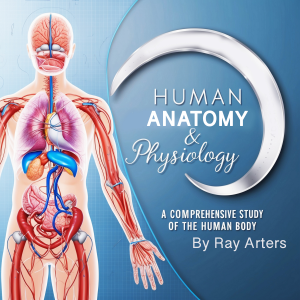

Human Anatomy & Physiology
Ray Arters
This audiobook is narrated by a digital voice.
The human body represents one of nature's most extraordinary achievements in biological engineering, a complex system of interconnected structures and processes that enable consciousness, movement, growth, and adaptation to an ever-changing environment. Understanding human anatomy and physiology requires appreciation for both the intricate details of individual components and the remarkable integration that allows these components to function as a unified whole.
The organizational hierarchy of the human body begins at the chemical level with atoms and molecules that form the building blocks of life. These fundamental units combine to create the four major types of biological macromolecules: carbohydrates, lipids, proteins, and nucleic acids. Each class of macromolecule serves specific structural and functional roles, from the energy storage capabilities of carbohydrates and lipids to the catalytic properties of enzymes and the information storage function of DNA.
Cellular organization represents the next level of complexity, where these macromolecules organize into membrane-bound compartments that carry out the basic functions of life. Human cells exhibit remarkable diversity in structure and function, from the oxygen-carrying red blood cells that lack nuclei to maximize hemoglobin content, to the elongated muscle cells specialized for contraction, to the branching neurons that transmit electrical signals across vast distances within the body.
Duration - 41m.
Author - Ray Arters.
Narrator - Digital Voice Matt G.
Published Date - Thursday, 30 January 2025.
Copyright - © 2025 Ray Arters ©.
Location:
United States
Description:
This audiobook is narrated by a digital voice. The human body represents one of nature's most extraordinary achievements in biological engineering, a complex system of interconnected structures and processes that enable consciousness, movement, growth, and adaptation to an ever-changing environment. Understanding human anatomy and physiology requires appreciation for both the intricate details of individual components and the remarkable integration that allows these components to function as a unified whole. The organizational hierarchy of the human body begins at the chemical level with atoms and molecules that form the building blocks of life. These fundamental units combine to create the four major types of biological macromolecules: carbohydrates, lipids, proteins, and nucleic acids. Each class of macromolecule serves specific structural and functional roles, from the energy storage capabilities of carbohydrates and lipids to the catalytic properties of enzymes and the information storage function of DNA. Cellular organization represents the next level of complexity, where these macromolecules organize into membrane-bound compartments that carry out the basic functions of life. Human cells exhibit remarkable diversity in structure and function, from the oxygen-carrying red blood cells that lack nuclei to maximize hemoglobin content, to the elongated muscle cells specialized for contraction, to the branching neurons that transmit electrical signals across vast distances within the body. Duration - 41m. Author - Ray Arters. Narrator - Digital Voice Matt G. Published Date - Thursday, 30 January 2025. Copyright - © 2025 Ray Arters ©.
Language:
English
Start
Duration:00:41:30